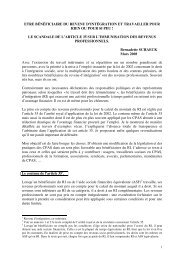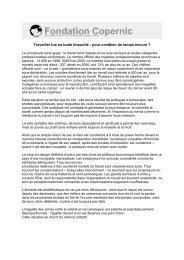Awra Amba RJ 300612 EN - Contacter un comité local d'Attac
Awra Amba RJ 300612 EN - Contacter un comité local d'Attac
Awra Amba RJ 300612 EN - Contacter un comité local d'Attac
You also want an ePaper? Increase the reach of your titles
YUMPU automatically turns print PDFs into web optimized ePapers that Google loves.
Introduction<br />
The Ethiopian village of <strong>Awra</strong> <strong>Amba</strong> is a well-established comm<strong>un</strong>ity with a truly extraordinary life<br />
style, especially in terms of equality between men and women, comm<strong>un</strong>ity spirit, absence of religion,<br />
honesty, hard work, and democracy. A ferment for emancipation.<br />
<strong>Awra</strong> <strong>Amba</strong> is therefore in line with the long list of utopian comm<strong>un</strong>ities like the Adamites from<br />
Bohemia in the 15 th century, the Jesuit mission in Paraguay 1609-1768, Robert Owen’s model<br />
factories in the 1820s in Great Britain and the United States, the Guise Familistère in France,<br />
fo<strong>un</strong>ded by the industrialist Jean-Baptiste Godin, which ran from 1849 to 1968 and employed over<br />
2000 workers at the end of the 19 th century, the La Re<strong>un</strong>ion phalanstery in Texas, 1853-1875, which<br />
was a large farm up to 5000 hectares, the Icaria comm<strong>un</strong>ities in the US in the second half of the 19 th<br />
century, and finally the hippy comm<strong>un</strong>ities in the 1960-70s, or the Auroville adventure in India,<br />
which has attracted aro<strong>un</strong>d 2000 people since 1968.<br />
In Africa, social organisations similar to <strong>Awra</strong> <strong>Amba</strong> exist or have partially existed in numerous<br />
villages or small closed comm<strong>un</strong>ities. That way in Algeria with the Mozabits, Kabyles (Nait, 2006),<br />
East-Algerian Chaouis or Touaregs in the Sahara. They are autonomous societies or societies who<br />
deliberately isolated themselves from their comm<strong>un</strong>ity of origin like the Mozabits. We'll see <strong>Awra</strong><br />
<strong>Amba</strong> was also constructed in reaction to its society of origin, but is still part of it.<br />
As far as the potential for emancipation of the experiment is concerned – especially in terms of<br />
solidarity – <strong>Awra</strong> <strong>Amba</strong> is close to the minimum wage program set up in the village of Otjivero,<br />
Namibia. The basic monthly wage of about ten Euros for each citizen incredibly improved the<br />
conditions of its thousand residents by stimulating production and demand: The percentage of people<br />
living <strong>un</strong>der the poverty threshold has been reduced from 79 to 37 %. Before the experiment, about<br />
half the children suffered from malnutrition, today there are less than 10 %; 60% completed<br />
elementary schools; today there are 90 %. And the crime rate has gone down (Shindondola-Mote,<br />
2009; Schwab, 2010).<br />
Each of these past or present projects has its own specificities, and none of them are identical to<br />
<strong>Awra</strong> <strong>Amba</strong>. But the fo<strong>un</strong>ding idea is the same: against the surro<strong>un</strong>ding society or independent of it,<br />
to build a comm<strong>un</strong>ity which is organised according to its own rules, and which puts some of <strong>Awra</strong><br />
<strong>Amba</strong>’s values into practice. Local Society’s hostility is never far off, and in many cases this has put<br />
a stop to the experiment. Assuring the continuation of the project is often difficult - a lot of<br />
experiments in utopian socialism haven’t lasted more than 2 or 3 years, and the idea of spreading<br />
their influence elsewhere is only a dream. But these experiments are still examples for all present and<br />
future societies, and have an educative f<strong>un</strong>ction, since they provide a wealth of lessons concerning<br />
the emancipation of peoples and of citizens.<br />
The aim of this study is to collect and present as far as possible information on <strong>Awra</strong> <strong>Amba</strong> from<br />
available acco<strong>un</strong>ts, reports and studies, because this experiment seems us deserving, for Ethiopian<br />
naturally – but <strong>Awra</strong> <strong>Amba</strong> is there still well known, for Africans and for Westerners – who have<br />
access to very few documents as far as we know. Our aim is not only to accumulate data, but also to<br />
make a critical synthesis (in the scientific meaning), which allows to emphasize the contradictions of<br />
sources and the possible fields where few information.<br />
We present firstly our own method – the way we have worked, and then we place <strong>Awra</strong> <strong>Amba</strong> in<br />
time and geography. We present later the main values they refer to, then the social organisation of<br />
the village, with a specific analysis of education. Finally we mention the external relations of the<br />
comm<strong>un</strong>ity, before look in conclusion at the lessons and risks for the future of this comm<strong>un</strong>ity some<br />
decades old.<br />
13 /85

















